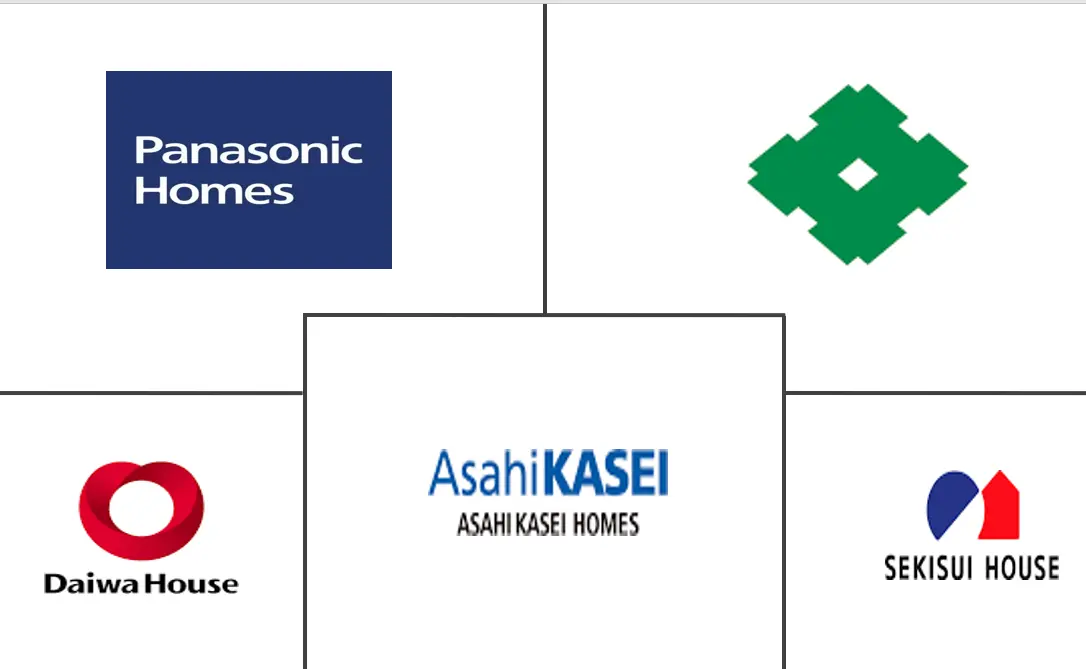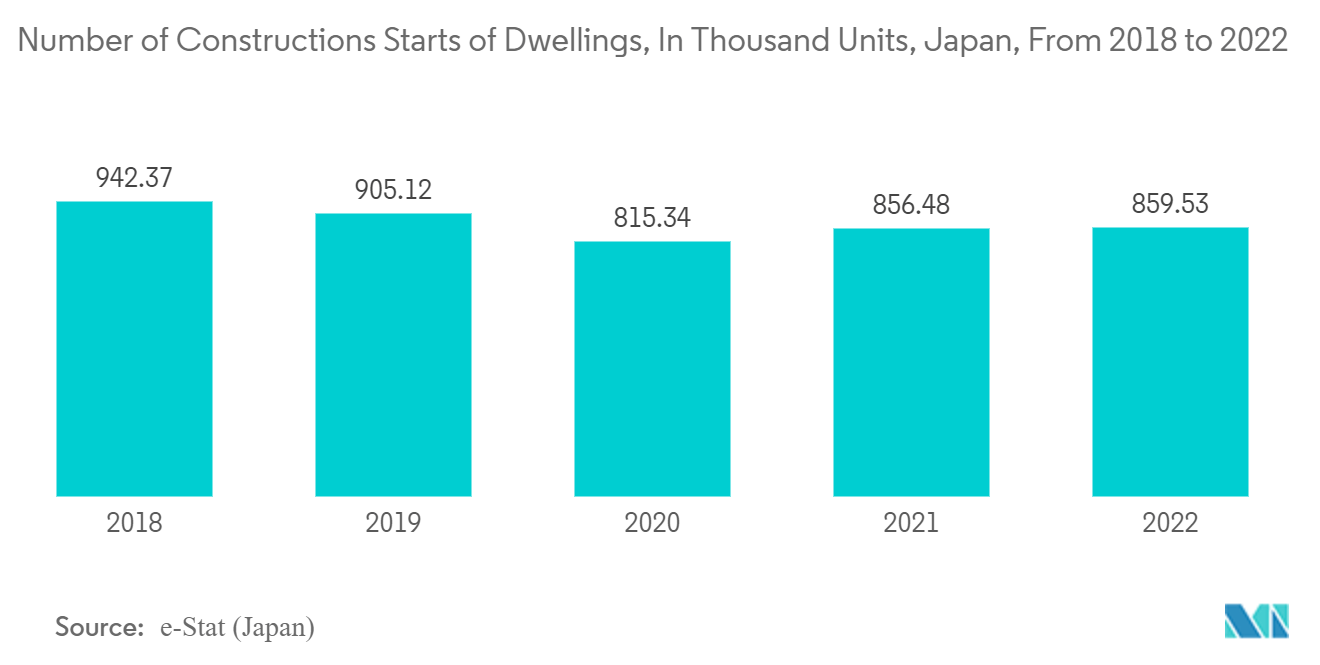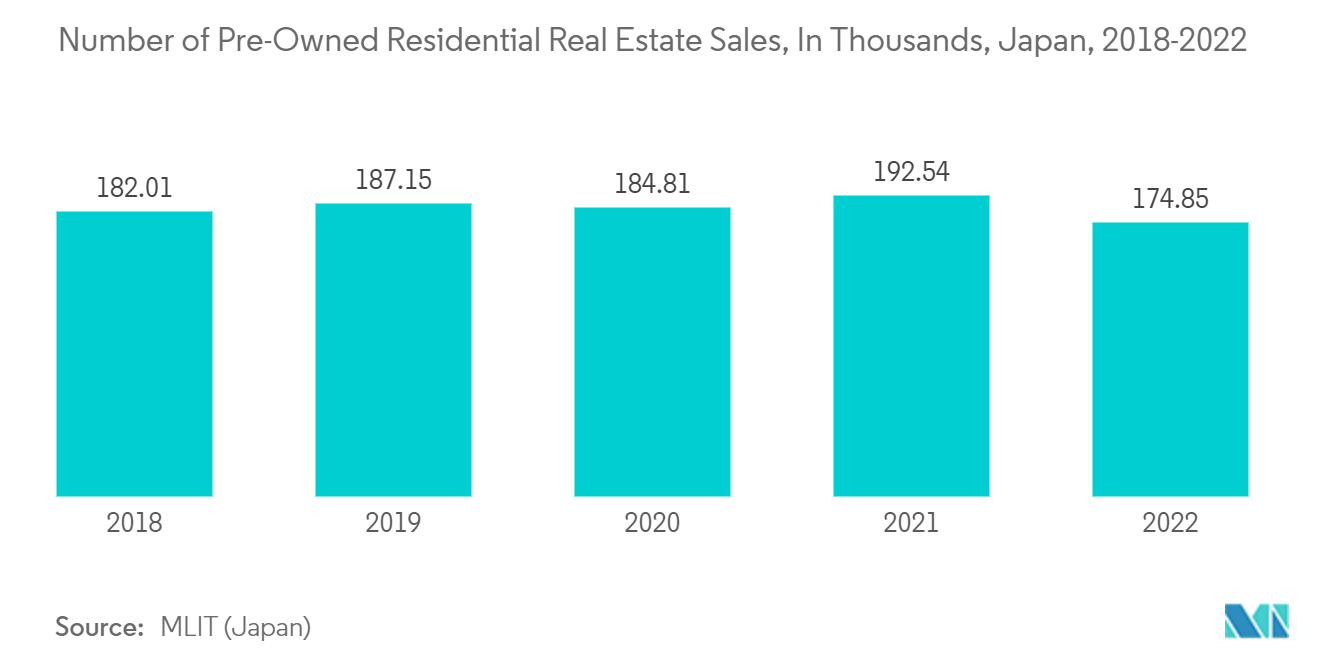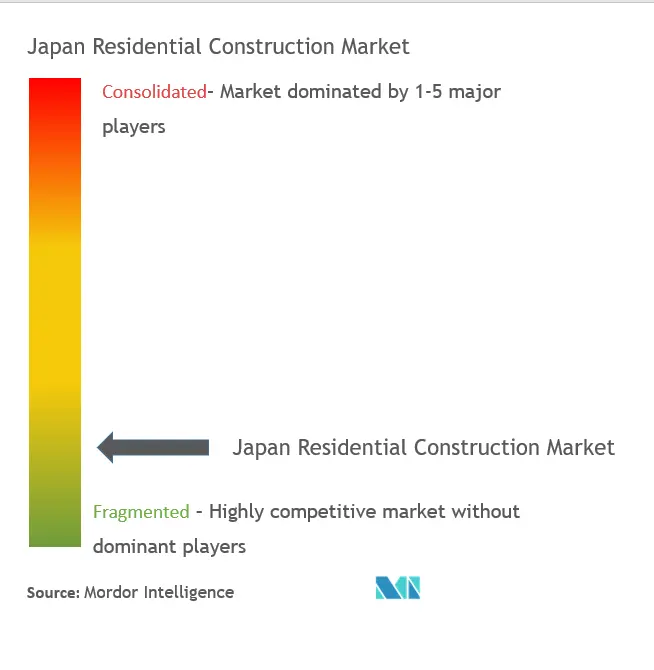Japan Residential Construction Market Size

| Study Period | 2020 - 2029 |
| Base Year For Estimation | 2023 |
| Forecast Data Period | 2024 - 2029 |
| Historical Data Period | 2020 - 2022 |
| CAGR | 5.00 % |
| Market Concentration | Medium |
Major Players
*Disclaimer: Major Players sorted in no particular order |
Japan Residential Construction Market Analysis
The Japan residential construction market is valued at about USD 263.66 billion and is expected to register a CAGR of more than 5% during the forecast period.
The Japanese residential construction market is anticipated to register a CAGR of greater than 5% during the forecast period.
The COVID-19 pandemic has caused the construction of residential properties to be halted in Japan. This slowed the growth of the residential construction market in 2020, but it was picking up in 2021 and 2022.
Japan is rapidly constructing high-rise condominiums in urban areas while new residential areas continue to sprout up in the suburbs. On the other hand, at the same time, the number of vacant houses is increasing in Japan. This is because people have shifted their focus more toward purchasing second-hand homes and abandoned homes.
Condominium prices had reached 180.3, or 1.8 times the median, as of April 2022. According to the industry association, the average price of a new condominium per 70 square meters in central Tokyo in 2021 would be JPY 87.57 million, JPY 64.75 million in the surrounding metropolitan area, and JPY 59.43 million in Osaka. High-earning couples are said to be driving demand for such expensive homes, buying condos to live in, invest in, or reduce their inheritance tax burden. This increase in the cost of new units is also pushing up the cost of used condominiums.
Price increases in Japan's residential construction market are not always a result of greater demand. After all, as a result of the rise in work-from-home, some office space will be turned into flats, increasing the supply of apartments. For instance, the builder of Tokyo Station's "Torch Tower," the city's highest tower, recently revealed plans for 50 luxury apartments with monthly prices ranging from 1 to 5 million yen. The Real Estate Economic Institute predicted that 14,000 new apartments would hit the market in Tokyo's 23 wards in 2022, a rise of 1.4% from the previous year. This prediction indicates that 34,000 units will be made available in the greater Tokyo area (+4.6%).
Japan Residential Construction Market Trends
Foreign Investments in Japan is Driving the Market
Foreigners are permitted to own land and residences in Japan, one of the few Asian countries that allow it. Foreigners are permitted to buy as well as own freehold property in Japan. Foreigners have the same rights as Japanese when purchasing real estate in Japan, whether it's a house in Tokyo or an apartment in Osaka. This factor is driving tremendous foreign investments in the country.
Moreover, Japan's slowly but steadily rising house prices, excellent infrastructure for home construction, and an increase in resources and agencies for acquiring abandoned, often ultra-cheap homes have resulted in openness to foreign investors. Non-Japanese are entering the Japanese housing market to purchase real estate as a primary, secondary, or investment property.
Analysts predict that demand from overseas investors will remain strong during the forecast period, particularly for logistics and residential properties, where foreign groups may be more aggressive buyers than domestic investors. Overseas buyers are also likely to continue to participate in large-ticket transactions.
To promote inward foreign direct investment in Japan to enhance the growth potential of the Japanese economy and to revitalize regional economies, the government created the 'Strategy for Promoting Foreign Direct Investment in Japan,' which was adopted by the Council for Promotion of Foreign Direct Investment in Japan. It sets a new target to double the inward foreign direct investment stocks to JPY 80 trillion by 2030 and reach 12% of GDP, according to Invest Japan.

Rising Sales of Second-Hand Apartment is Driving the Renovation Sector in Japan
One of the factors driving the sales of second-hand homes in Japan is the Bank of Japan's ultra-low interest rate policy, which is, of course, a key driver of residential home sales. These ultra-low rates have made it much more viable for people considering the leap to home ownership. The Bank of Japan (BOJ) has also indicated that it plans to continue its negative interest rate policy after 2023. Other driving factors for second-hand home sales are high prices in the new condominium market and pent-up demand. In 2022, the number of pre-owned residential real estate sales in Japan accounted for about 174.85 thousand. Compared to the previous year, the number of existing properties sold decreased by 9.2%, according to MLIT (Japan).
The booming second-hand home sales market is an abandoned home sales market that has highly accelerated the need for renovation in Japan. As people get these houses at affordable rates, they pay more attention to renovating them to meet their requirements. Furthermore, renovation is considered important to maintain luxury and comfort in the residential sector.

Japan Residential Construction Industry Overview
The Japan residential construction market is quite fragmented, with many local players in the market. Some of the major players in the market are Daiwa House, Sekisui House, Panasonic Homes, Asahi Kasei Homes, and Sumitomo Forestry. The market is expected to grow during the forecast period due to the increase in residential construction investments, upcoming major projects in the country, and other factors driving the market. The major local and international players have created a relatively fair enough competitive environment in the market. Still, the market opens opportunities for small and medium players due to increasing govt investments in the sector.
Japan Residential Construction Market Leaders
-
Daiwa House
-
Sekisui House
-
Panasonic Homes
-
Asahi Kasei Homes
-
sumitomo forestry
*Disclaimer: Major Players sorted in no particular order

Japan Residential Construction Market News
- November 2022: Asahi Kasei Homes acquired 100% ownership of all the subsidiaries of Focus Company. This acquisition will help Asahi Kasei Homes strengthen its core business of order-built unit homes in Japan, North America, and Australia.
- April 2022: Panasonic Homes commenced selling their Casart Black & Stone model, a Zero Energy Home (ZEH), in April 2022. The Black & Stone has an Earthquake Safety and Comfort Warranty that will restore the building to its original condition in the unlikely event that more than half of the house is damaged in an earthquake. The Black & Stone has a Grade 3 rating, the highest seismic performance rating that is achievable, under the Housing Performance Indication System.
Table of Contents
1. INTRODUCTION
- 1.1 Study Deliverables
- 1.2 Study Assumptions
- 1.3 Scope of the Study
2. RESEARCH METHODOLOGY
3. EXECUTIVE SUMMARY
4. MARKET INSIGHTS
- 4.1 Current Market Scenario
- 4.2 Technological Trends
- 4.3 Industry Value Chain/Supply Chain Analysis
- 4.4 Government Regulations and Key Initiatives in the Market
- 4.5 Brief on Different Structures Used in the Residential Construction Industry.
- 4.6 Impact of COVID-19 on the Market
5. MARKET DYNAMICS
- 5.1 Market Overview
- 5.2 Market Drivers
- 5.3 Market Restraints
- 5.4 Value Chain / Supply Chain Analysis
-
5.5 Porter's Five Forces Analysis
- 5.5.1 Threat of New Entrants
- 5.5.2 Bargaining Power of Buyers/Consumers
- 5.5.3 Bargaining Power of Suppliers
- 5.5.4 Threat of Substitute Products
- 5.5.5 Intensity of Competitive Rivalry
6. MARKET SEGMENTATION
-
6.1 By Type
- 6.1.1 Apartment & Condominiums
- 6.1.2 Villas
- 6.1.3 Other Types
-
6.2 By Construction Type
- 6.2.1 New Construction
- 6.2.2 Renovation
7. COMPETITIVE LANDSCAPE
- 7.1 Market Concentration Overview
-
7.2 Company Profiles
- 7.2.1 Daiwa House
- 7.2.2 Sekisui House
- 7.2.3 Panasonic Homes
- 7.2.4 Asahi Kasei Homes
- 7.2.5 sumitomo forestry
- 7.2.6 Mitsui Homes
- 7.2.7 Prime Life Technologies
- 7.2.8 Misawa Homes
- 7.2.9 Toyota Housing Co
- 7.2.10 Tama Home*
- *List Not Exhaustive
8. MARKET OPPORTUNITIES AND FUTURE TRENDS
9. APPENDIX
** Subject To AvailablityJapan Residential Construction Industry Segmentation
Residential construction includes construction on single-family or two-family dwellings that are occupied or used or are intended to be occupied or used, primarily for residential purposes. One in which the architect uses materials to construct the complete structure according to customers' tastes and choices before selling it to the buyers at a profit. The Japanese residential construction market is segmented by type (apartments & condominiums, villas, and other types) and by construction type (new construction and renovation). The report offers market size and forecasts for Japan's residential construction market in value (USD billion) for all the above segments.
| By Type | Apartment & Condominiums |
| Villas | |
| Other Types | |
| By Construction Type | New Construction |
| Renovation |
Frequently Asked Questions
What is the current Japan Residential Construction Market size?
The Japan Residential Construction Market is projected to register a CAGR of greater than 5% during the forecast period (2024-2029)
Who are the key players in Japan Residential Construction Market?
Daiwa House, Sekisui House, Panasonic Homes, Asahi Kasei Homes and sumitomo forestry are the major companies operating in the Japan Residential Construction Market.
What years does this Japan Residential Construction Market cover?
The report covers the Japan Residential Construction Market historical market size for years: 2020, 2021, 2022 and 2023. The report also forecasts the Japan Residential Construction Market size for years: 2024, 2025, 2026, 2027, 2028 and 2029.
Japan Residential Construction Industry Report
Statistics for the 2024 Japan Residential Construction market share, size and revenue growth rate, created by Mordor Intelligence™ Industry Reports. Japan Residential Construction analysis includes a market forecast outlook to for 2024 to 2029 and historical overview. Get a sample of this industry analysis as a free report PDF download.



